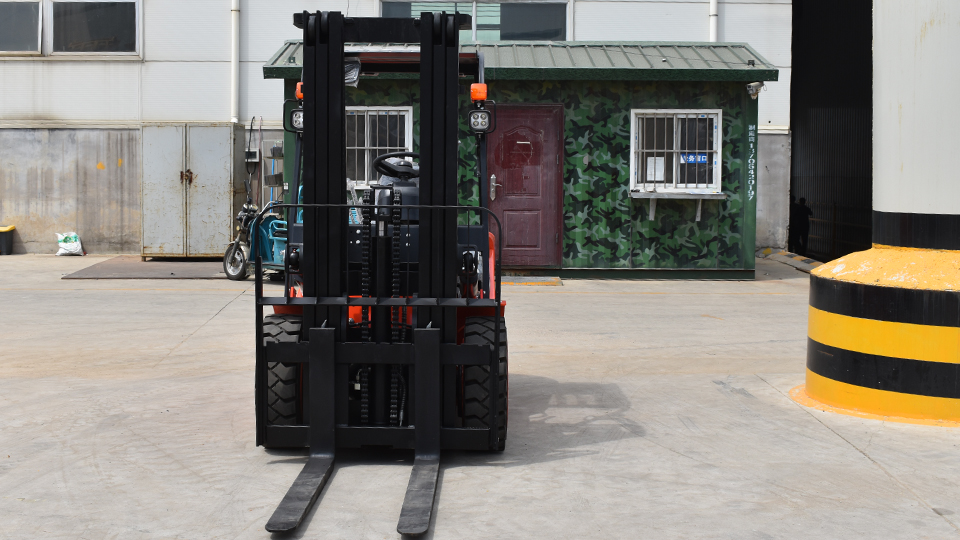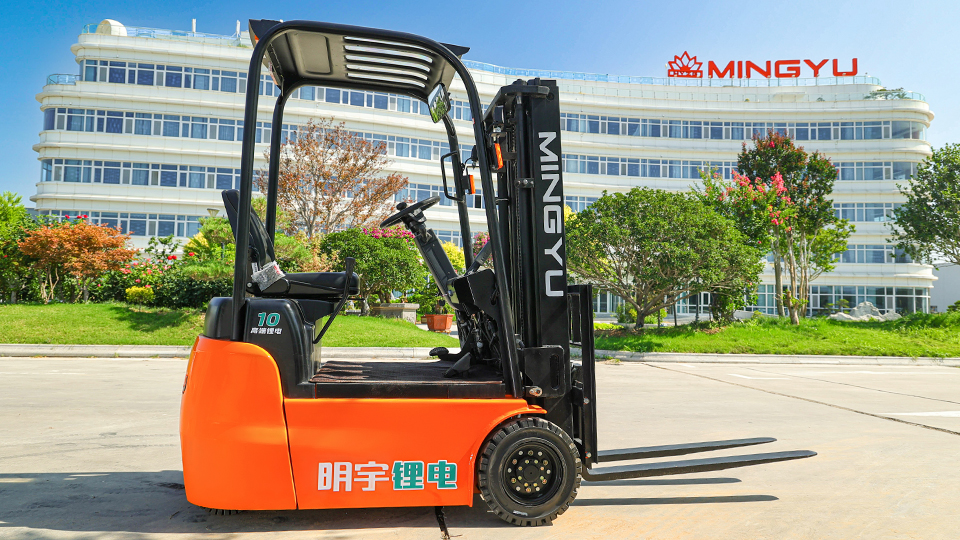
What to Do if a Forklift Tips Over: A Technical and Emergency Response Protocol
The overturning of a Powered Industrial Truck (PIT), commonly known as a forklift, is one of the most hazardous incidents in material handling operations. According to the Occupational Safety and Health Administration (OSHA), tip-overs are a leading cause of fatalities involving forklifts, primarily due to operators attempting to jump clear of the machine and becoming pinned or crushed by the overhead guard (OHG).
This technical article details the precise, bifurcated emergency response protocol—dictated by OSHA standards and industry best practices—that operators must follow during a tip-over, differentiated by the two primary modes of instability: lateral (sideways) and longitudinal (forward/backward).

1. The Physics of the Tip-Over: Stability and the Hazard
All forklift safety procedures are fundamentally based on the concept of the Stability Triangle. A counterbalanced forklift is supported by a three-point suspension system: the center of the rear axle and the two front wheels. The imaginary triangle connecting these three points defines the machine’s stable operating zone.
A tip-over occurs when the combined center of gravity (CCG) of the truck and its load moves outside the boundaries of this stability triangle.
A. Lateral (Sideways) Tip-Over
Cause: This is the most common and often the deadliest type. Causes include:
Turning too sharply, especially at high speeds.
Driving on uneven, soft, or sloped surfaces.
Driving with the load elevated.
Sudden impact with an object (e.g., a pothole or curb).
Vector of Force: The centrifugal force of the turn or the gravitational pull of the slope shifts the CCG laterally, causing the machine to roll over its side.
B. Longitudinal (Forward/Backward) Tip-Over
Cause: Less common but equally dangerous. Causes include:
Excessive overloading beyond the rated capacity.
Carrying the load with the mast tilted too far forward.
Sudden braking, especially with a heavy, elevated load.
Driving down a ramp or grade with the load positioned downgrade.
Vector of Force: The CCG shifts longitudinally, causing the machine to pivot over its front axle (forward) or rear axle (backward).
2. The Emergency Response: Immediate Operator Action
OSHA and every major safety body mandate a clear, instantaneous, and counter-intuitive response to a tip-over, which hinges on the type of truck the operator is using.
A. The Protocol for Sit-Down Counterbalanced Trucks (Classes I, IV, V)
The most crucial rule—supported by decades of accident data—is to NEVER JUMP. The overhead guard (OHG) is the operator's primary protection, but its function is to prevent falling objects, not to protect in a tip-over. When the machine tips, the operator's momentum propels them toward the point of impact. If they jump, they are almost always crushed by the OHG or mast assembly.
The immediate, non-negotiable procedure is a rapid sequence of bracing and leaning:
1. Stay in the Truck and Fasten the Seat Belt
The seat belt is the single most critical safety device in a tip-over. Its purpose is not for frontal collisions, but to restrain the operator within the protective cage of the operating compartment, preventing ejection. If not already worn, the operator must secure it instantly, even as the machine begins to roll.
2. Grip the Steering Wheel Firmly
Do not attempt to steer, as the wheels are irrelevant. The steering wheel becomes a critical anchor point for the upper body.
The recommended technique is to grasp the steering wheel firmly with both hands, either over or under the wheel, and use the force to stabilize the torso.
3. Brace Feet and Lean
Lateral Tip-Over (Sideways Roll):
Brace both feet firmly against the floorboard.
Lean Hard AWAY from the point of impact. If the forklift is tipping to the left, the operator must push themselves to the right, into the seat corner, and away from the potential crushing zone between the OHG and the ground. This counter-lean protects the head and neck.

Lean slightly forward to secure the spine against the seat back.
Longitudinal Tip-Over (Forward Pitch):
Brace both feet firmly against the floorboard.
Lean FORWARD and slightly down, pulling the head below the top of the OHG structure. This prevents the head from colliding with the top of the overhead guard, which can become a shearing point as the machine pitches.
4. Wait for the Impact to Complete
The operator must remain in this braced position until the forklift has come to a complete and final rest. The instinct to move must be suppressed until all movement has stopped.
B. The Protocol for Stand-Up Trucks
For certain classes of forklifts, such as Stand-Up, Rear-Entry Reach Trucks (Class II), the tip-over protocol is fundamentally different. These trucks are not equipped with a seat belt or a full protective compartment like a sit-down counterbalance truck.
In the event of a tip-over on a stand-up truck:
Look for an Exit: Identify the direction opposite the fall.
Step Back and Away: The operator must quickly step backward out of the operator compartment and move clear of the truck’s path, allowing the machine to fall unimpeded.
Critical Distinction: This exception is only valid for stand-up trucks where the operator is not restrained and is designed to exit. Attempting this maneuver in a belted, sit-down truck is lethal.
3. Post-Incident Emergency Response (The Ground Crew)
The actions taken by personnel on the ground after the tip-over are crucial for minimizing further risk and initiating the emergency plan.
A. Securing the Scene
Isolate the Area: Immediately initiate a "Lockout Zone." Clear all non-essential personnel from the area to prevent secondary injuries from falling cargo, leaking fuel, or the recovery operation.
Verify Operator Status: Without entering the immediate danger zone, visually assess the operator.
If the operator is conscious and restrained, instruct them to remain completely still until the machine is fully stabilized and rescue personnel arrive.
If the operator is unconscious or appears trapped, do not attempt to move the machine or the load yourself.
Emergency Notification: Call emergency services (e.g., 911 or internal emergency team) immediately. Provide precise details:
Location (Aisle, Rack, Bay Number).
Machine Type (Forklift, Telehandler).
Operator Status (Conscious, Trapped, Injury Type).
Cargo Status (Is the load stable or is there a risk of a secondary collapse?).
B. Containment and Hazard Mitigation
Ignition and Power: The first recovery step must be to neutralize all potential energy sources.
Internal Combustion (LP, Gas, Diesel): Locate the master shut-off switch or the key and turn off the ignition. If it is an LP-Gas truck, turn the valve on the propane cylinder to the OFF position to prevent fuel leakage.
Electric: Disconnect the battery terminal (if safe to reach) or engage the emergency disconnect button.
Fluid Containment: Check for fluid leaks (hydraulic fluid, engine oil, fuel). Use spill containment kits and absorbent materials to mitigate fire and slip hazards. This step is critical if the machine is near ignition sources or sensitive inventory.
4. Documentation, Investigation, and Remedial Action
Once the immediate threat is contained and the operator is safely extricated and treated, the focus shifts to compliance, documentation, and prevention.
A. Incident Documentation
A thorough investigation must be launched immediately to determine the root cause, satisfying OSHA requirements and internal safety protocols.
Formally Record: Log the date, time, location, and conditions (weather, lighting, floor surface).
Gather Evidence: Take clear photographs of:
The final resting position of the forklift.
The load (condition, placement on forks, integrity).
Any environmental factors (potholes, debris, ramp angle).
The capacity plate (to verify against the load).
Operator and Witness Statements: Obtain detailed, non-judgmental accounts from the operator and all witnesses as soon as possible, while memories are fresh.
B. Determining the Root Cause
The investigation must move beyond "operator error" to identify the system failures that led to the incident.
Root Cause Category Contributing Factors System Failure Example
Operational Excessive speed, sharp turning, carrying load too high, sudden braking. Inadequate supervision; lack of clear traffic planning.
Load Handling Overloading, off-center load, load not secured, tilting mast forward on slope. No process for verifying load weight; incorrect attachment use.
Environmental Unmarked floor defects, poor lighting, obstructed visibility, insufficient ramp slope warning. Poor facility maintenance schedule; inadequate signage.
Mechanical Brake failure, hydraulic leak, faulty steering, improper tire type for terrain. Failure to conduct mandatory pre-shift inspection; deferred maintenance.
C. Remedial and Preventive Action
Following the investigation, mandatory remedial steps must be taken:
Repair/Replacement: The damaged forklift must be immediately tagged "Out of Service" and assessed by qualified technicians. It must not return to service until all repairs are completed and certified.
Retraining: The operator involved, and potentially all operators, must undergo immediate refresher training focusing specifically on the causes of the tip-over (e.g., stability principles, safe cornering, load handling limits).
Procedure Review: Review and update all operating procedures, especially for high-risk areas identified by the incident. This may involve implementing speed limiters, installing convex mirrors at blind corners, or re-routing pedestrian traffic.
Conclusion
The universal technical standard for a forklift tip-over emergency is clear: stay with the machine, brace, and lean away from the impact. This singular, consistent directive is derived from the non-negotiable principle that the operator's survival is paramount, and ejection from the vehicle is the primary cause of fatality.
A comprehensive safety program requires not just teaching this emergency response, but vigorously enforcing the operational and load-handling rules to ensure the center of gravity never leaves the stability triangle in the first place. The response to a tip-over begins long before the machine starts to fall.
Name: selena
Mobile:+86-13176910558
Tel:+86-0535-2090977
Whatsapp:8613181602336
Email:vip@mingyuforklift.com
Add:Xiaqiu Town, Laizhou, Yantai City, Shandong Province, China